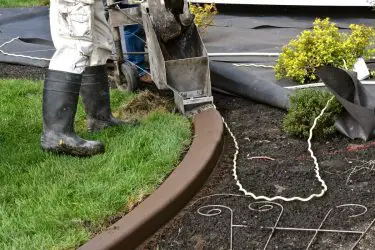Properly installed concrete is highly durable, requiring little to no maintenance. Its wind, water, and heat resistance make it a popular material in construction. However, settling on the right quantity of concrete to use on a specific portion of a project isn’t always straightforward as it shrinks when it cures.
Concrete can shrink by as much as half-inch (1.27 cm) per 100 feet (30.5 m) when it cures – a type of shrinking known as drying shrinkage. It is caused by the evaporation of excess water used in the mixing process. In some cases, this shrinkage can cause visible cracks in the cured concrete.
In this article, you’ll learn why concrete shrinks while curing and why the shrinkage causes cracks. You’ll also learn how to prevent concrete shrinkage and cracks.

Table of Contents
Why Concrete Shrinks
For concrete to hydrate and gain strength over time, you need to add a minimum of 26 gallons (98.4 liters) of water per yard of the measured slump.
Any quantity of water above the recommended 26 gallons (98.4 liters) of water only helps make the concrete mixture more malleable for pumping or pouring.
The excess water is not useful for the hydration process, and thus it seeps out of the concrete once poured and allowed to cure. With the water leaving the concrete, a volume change is visible. This type of shrinking is known as dry shrinkage.
Generally, if the mixed concrete doesn’t have enough strength to cope with this volume change during the curing stage, it will most likely crack.
How Long Before Concrete Starts To Shrink?
Concrete typically sets within 48 hours. At this point, you can walk on it. However, partial curing only occurs a week after.
During this stage, any shrinkage will likely be visible. You can also continue building and construction at this point, but the concrete can’t take any heavy equipment at this stage.
Concrete mixes will likely cure completely after one month.
Read more: Time for Concrete to Cure and Turn White: How long will it take?
Can You Prevent Concrete Shrinkage?
With concrete shrinking by up to half-inch (1.27 cm) for every 100 feet (30.5 m) and the cracking and disfiguring that often follows, it makes sense to look for ways to prevent the shrinkage in the first place. Is this possible?
It’s challenging to prevent concrete shrinkage completely. However, maintaining the right water-cement ratio when mixing can go a long way towards preventing shrinkage and cracking.
If you need to increase the workability of the mix, you should consider using admixtures to increase your slump instead of adding more water.
There are different types of additives you can use, and they are grouped into the following:
- Shrinkage-reducing additives: These decrease the tension on the surface of the water within the concrete.
- Water-reducing additives: These improve mix fluidity without relying on the water as the main agent.
These agents contain a compressive force that will prevent concrete shrinkage as long as they remain active.
Also, you should keep in mind that environmental conditions can have an impact on the concrete. Low humidity and high heat conditions can cause shrinkage.
You should avoid pouring concrete on a very dry subgrade. It needs to be moist to prevent water from dissipating too quickly into the dry soil. Are you working with rebar? Cool it down first before placement.
Some experts recommend covering the concrete surface with burlap, plastic, or polyethylene sheets if you are working in extremely hot temperatures, direct sunlight, or similar harsh conditions.
You should also consider placing concrete in periods of the day when the weather is most friendly—think late evenings for extremely hot weather.
You can also further reduce the chances of concrete shrinkage by curing the surface using a curing compound or moisture evaporation inhibiting mixtures.
Is Watering Concrete To Prevent Shrinkage and Cracks a Good Idea?
Watering concrete in the morning (and during the hottest parts of the day) in hot regions is a good way to reduce cracks and shrinkage. It won’t prevent these problems completely, but it can significantly lower the impact of hot weather on the concrete.
Remember, you have to start watering in the morning, only topping up during the hottest part of the day. Starting watering from the hottest part of the day will only shock the concrete, causing surface crazing.
You should water new concrete regularly regardless of the predominant conditions. Ideally, you should hose it down 5-10 times over the course of the day, especially during the first seven days.
Can Concrete Expand After Shrinkage?
Most of the shrinkage after concrete cures is irreversible. However, it does indeed expand in extreme heat or when the moisture content changes.
This is why concrete bridges are constructed with room for expansion. Expanding concrete, however, won’t fully return to the pre-shrinkage condition.
Reasons for Concrete Cracks
There are a few reasons why concrete will crack:
- Weather-dependent cracks: If the weather is excessively hot or windy, the concrete’s surface will lose moisture faster than it can handle, leading to plastic shrinkage and cracking. This can happen right after the concrete is poured until the final phase of curing. The cracks here will only appear on the surface, lacking depth.
- Drying shrinkage cracks: Excess water not used in hydration leaves the concrete around the final curing time (usually around a week after pouring). This process can lead to full depth cracks. However, you can make the crack look better by installing 8-12ft (2.4-3.7m) joints in a square layout to make the cracking take a more defined and aesthetically pleasing shape rather than appear randomly over the poured concrete.
- Thermal differential cracks: This occurs when the top of the concrete is drying faster than the bottom. This type of cracking is easy to identify as it typically leaves wide gaps and has a rough appearance. You’ll find this type of crack when the concrete has been poured on surfaces where heat doesn’t get through the cement from below.
What Is the Best Way To Prevent Concrete Cracks?
The tips recommended for preventing concrete shrinkage will also help you avoid cracks.
The best tip is to ensure you’ve taken the right steps to maintain moisture in the cement in the first few days after pouring.
The concrete is less likely to crack if you ensure slow evaporation. So, techniques like spraying water a few times per day will also work here.
Hot weather isn’t the only thing you should watch out for. Cold weather below 50°F (10°C) can also cause cracks because such temperatures can weaken the mix’s internal structure.
If the forecast shows you’re likely to experience extremely cold weather, you should cover the newly poured concrete with some insulating blankets and polyethylene sheets that are a minimum of four millimeters (0.16 inches) thick. Don’t uncover the concrete to spray it with water in this scenario.
Read more: Pouring Concrete in the Cold: How to ensure it won’t crack
Remember, the bulk of the weather-related shrinkage and cracks prevention tips are most important within the first week of pouring the concrete.
After it has cured for a week, the mix is strong enough to withstand extreme weather changes.
Conclusion
Concrete shrinks by up to half an inch (1.27 cm) per 100 feet (30.5 m) after it has cured. To prevent this, you should adopt best concrete mixing practices, ensuring the perfect water to cement ratio instead of using excess water to improve workability.
Shrinkage prevention techniques also continue once the concrete is poured. Hosing down the concrete in the early days and throughout the curing period can reduce the impact of harsh environmental factors on the mix, making the concrete less susceptible to shrinkage and cracks.



